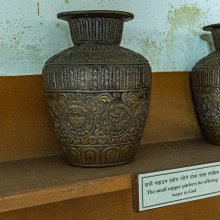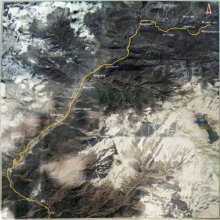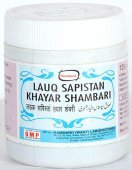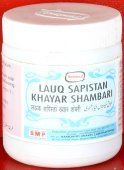Shana, Śaṇa, Śana, Sāṇa, Saṇa, Sanā, Sana, Śānā, Saṅa: 28 definitions
Introduction:
Shana means something in Hinduism, Sanskrit, Jainism, Prakrit, Buddhism, Pali, the history of ancient India, Marathi, Hindi, biology, Tamil. If you want to know the exact meaning, history, etymology or English translation of this term then check out the descriptions on this page. Add your comment or reference to a book if you want to contribute to this summary article.
The Sanskrit terms Śaṇa and Śana and Śānā can be transliterated into English as Sana or Shana, using the IAST transliteration scheme (?).
Alternative spellings of this word include Saan.
Images (photo gallery)
In Hinduism
Ayurveda (science of life)
Rasashastra (Alchemy and Herbo-Mineral preparations)
Source: Wisdom Library: Rasa-śāstraŚana (शन) is a Sanskrit technical term translating to “jute”, a vegetable fibre commonly used for making cloth. It is used throughout Rasaśāstra literature, such as the Rasaprakāśasudhākara.
Nighantu (Synonyms and Characteristics of Drugs and technical terms)
Source: WorldCat: Rāj nighaṇṭuŚaṇa (शण) is the Sanskrit name for a medicinal plant identified with Crotalaria juncea Linn. (“Indian hemp”) from the Fabaceae or “legume” family of flowering plants, according to verse 4.75-76 of the 13th-century Raj Nighantu or Rājanighaṇṭu. Śaṇa is commonly known in Hindi as Sana or Sanāi; in Bengali as Shonpat or Ghoresun; in Marathi as Sana; in Gujarati as Tagā or Sana; and in Telugu as Janumū.
Śaṇa is mentioned as having seven synonyms: Mālyapuṣpa, Vamana, Kaṭutiktaka, Niśāvaṇa, Dīrghaśākha, Tvaksāra and Dīrghapallava.
Properties and characteristics: “Śaṇa is sour (amlarasa) and stringent. It is ecbolic and causes bleeding and vomiting, alleviates the disorders caused due to vitiated vāta and kapha. It relieves severe body-ache”.
Unclassified Ayurveda definitions
Source: Wisdom Library: Āyurveda and botanyŚana (शन) is a Sanskrit word referring to Crotalaria verrucosa (blue rattlepod), from the Fabaceae family. Certain plant parts of Śana are eaten as a vegetable (śāka), according to Caraka in his Carakasaṃhitā sūtrasthāna (chapter 27), a classical Ayurvedic work. The plant is therefore part of the Śākavarga group of medicinal plants, referring to the “group of vegetables/pot-herbs”. The herb is found throughout Asia in countries such as India, Nepal, Bangladesh and Sri Lanka. A variant spelling named Śaṇa (शण) is also mentioned in the same list.
Source: gurumukhi.ru: Ayurveda glossary of termsŚāṇa (शाण):—A unit of Measurement; Four mashas are equal to one sana = 3 g of metric units

Āyurveda (आयुर्वेद, ayurveda) is a branch of Indian science dealing with medicine, herbalism, taxology, anatomy, surgery, alchemy and related topics. Traditional practice of Āyurveda in ancient India dates back to at least the first millenium BC. Literature is commonly written in Sanskrit using various poetic metres.
Yoga (school of philosophy)
Source: ORA: Amanaska (king of all yogas): A Critical Edition and Annotated Translation by Jason BirchŚana (शन) refers to “slowly (drawing in the breath)”, according to the Dattātreyayogaśāstra verse 35-38ab.—Accordingly, while describing the lotus pose (padmāsana): “Having carefully placed the upturned feet on the thighs and the upturned hands in between the thighs, [the Yogin] should fix the eyes on the tip of the nose. Having lifted the uvula with the tongue; having fixed the chin on the chest and having drawn in the breath slowly (śana) according to his capacity, he should fill [the region of] the stomach. After that, he should exhale the breath slowly according to his capacity. This is said to be padmāsana, which destroys all diseases”.

Yoga is originally considered a branch of Hindu philosophy (astika), but both ancient and modern Yoga combine the physical, mental and spiritual. Yoga teaches various physical techniques also known as āsanas (postures), used for various purposes (eg., meditation, contemplation, relaxation).
General definition (in Hinduism)
Source: archive.org: Vedic index of Names and SubjectsŚaṇa (शण) denotes a kind of ‘hemp’ (Cannabis sativa or Crotolaria juncea). It is mentioned in the Atharvaveda as growing in the forest, and as used like the Jaṅgiḍa as a remedy against Viṣkandha. It also occurs in the Śatapatha-brāhmaṇa.
In Jainism
General definition (in Jainism)
Source: archive.org: Jaina YogaSana (सन, “hemp”) refers to one of the seventeen varieties of dhānya (“grain”) according to Śvetāmbara tradition and listed in Hemacandra’s 12th century Yogaśāstra (verse 3.95). Dhānya represents one of the classes of the external (bahya) division of attachment (parigraha) and is related to the Aparigraha-vrata (vow of non-attachment).

Jainism is an Indian religion of Dharma whose doctrine revolves around harmlessness (ahimsa) towards every living being. The two major branches (Digambara and Svetambara) of Jainism stimulate self-control (or, shramana, ‘self-reliance’) and spiritual development through a path of peace for the soul to progess to the ultimate goal.
India history and geography
Source: Cologne Digital Sanskrit Dictionaries: Indian Epigraphical GlossaryŚaṇa.—(LP), linen. Note: śaṇa is defined in the “Indian epigraphical glossary” as it can be found on ancient inscriptions commonly written in Sanskrit, Prakrit or Dravidian languages.
--- OR ---
Śāṇa.—name of a weight or coin; a silver coin which was (1/8) of a śatamāna in weight and value; generally regarded as 40 ratis in weight, but sometimes also as 32 or 24 or 20 ratis; also called niṣka, ṭaṅka or dharaṇa or śānaka. See JNSI, Vol. XVI, pp. 42, 44-45. See śāna-pāda. Note: śāṇa is defined in the “Indian epigraphical glossary” as it can be found on ancient inscriptions commonly written in Sanskrit, Prakrit or Dravidian languages.
--- OR ---
Śāṇa.—name of a weight or a coin 40 ratis in weight; equal to 4 māṣas; sometimes regarded as 32 ratis and called niṣka and ṭaṅka; rarely also regarded as equal to 24 or 20 ratis. Note: śāṇa is defined in the “Indian epigraphical glossary” as it can be found on ancient inscriptions commonly written in Sanskrit, Prakrit or Dravidian languages.

The history of India traces the identification of countries, villages, towns and other regions of India, as well as mythology, zoology, royal dynasties, rulers, tribes, local festivities and traditions and regional languages. Ancient India enjoyed religious freedom and encourages the path of Dharma, a concept common to Buddhism, Hinduism, and Jainism.
Biology (plants and animals)
Source: Wisdom Library: Local Names of Plants and DrugsShana [शण] in the Sanskrit language is the name of a plant identified with Crotalaria pallida var. pallida from the Fabaceae (Pea) family having the following synonyms: Crotalaria javanica, Crotalaria striata var. acutifolia. For the possible medicinal usage of shana, you can check this page for potential sources and references, although be aware that any some or none of the side-effects may not be mentioned here, wether they be harmful or beneficial to health.
Source: Google Books: CRC World Dictionary (Regional names)Shana in India is the name of a plant defined with Crotalaria juncea in various botanical sources. This page contains potential references in Ayurveda, modern medicine, and other folk traditions or local practices It has the synonym Crotalaria juncea Willd. (among others).
Example references for further research on medicinal uses or toxicity (see latin names for full list):
· Annals of the Missouri Botanical Garden (1994)
· Revisio Generum Plantarum (1891)
· Species Plantarum. (1800)
· A Numerical List of Dried Specimens (5363)
· Encyclopédie Méthodique, Botanique (1786)
· Hortus Bengalensis (1814)
If you are looking for specific details regarding Shana, for example side effects, health benefits, diet and recipes, extract dosage, chemical composition, pregnancy safety, have a look at these references.

This sections includes definitions from the five kingdoms of living things: Animals, Plants, Fungi, Protists and Monera. It will include both the official binomial nomenclature (scientific names usually in Latin) as well as regional spellings and variants.
Languages of India and abroad
Pali-English dictionary
Source: Wisdom Library: Maha Prajnaparamita Sastra (Pali)Sāṇa (‘imperfect’) is a rare word. According to the Commentary of the Saṃyutta, it means, etymologically, sa-iṇa, ‘in debt’; in the figurative sense, sa-kilesa, ‘with passions’. The commentary does not specify which ones, but as sāṇa is opposed here to aññā, the perfect knowledge of the saints, we could take it that it is all the passions to be abandoned by seeing the truths, or darśanaheyakleśa (cf. Kośa). The sāṇa would be something like a good worldly person (pṛthagjana) practicing the three śikṣā (high morality, high thought, high wisdom) in view of the destruction of the impurities (saikṣa). The expression saikṣa pṛthagjanakalyāṇaka is time-honored (Divya).
Source: BuddhaSasana: Concise Pali-English Dictionarysāṇa : (nt.) hemp; a coarse hempen cloth.
Source: Sutta: The Pali Text Society's Pali-English DictionarySaṇa, (nt.) (Vedic śaṇa; Gr. kάnnabis=Lat. cannabis; Ags haenep=E. hemp; Ger. hanf. ) a kind of hemp D. II, 350 (v. l.); S. I, 115 (do.); cp. sāṇa1 & sāṇī.
— or —
1) Sāṇa, 2 (sa+iṇa) having a debt, indebted, fig. subjected to the kilesas, imperfect M. III, 127=S. II, 221 (=sakilesa, sa-iṇa K. S. II. 203); ThA. 8; cp. anaṇa under aṇa. (Page 702)
2) Sāṇa, 1 (nt.) (cp. Sk. śāṇa hempen, fr. śaṇa=P. saṇa; cp. bhaṅga1) hemp D. II, 350; Miln. 267; a coarse hempen cloth Vin. I, 58; D. I, 166; III, 41; M. I, 78; A. I, 240; S. II, 202, 221; Pug. 55; Vism. 54 (°sāṭaka).—sāṇavāka the same Th. 2, 252; J. III, 394 (var. read). (Page 702)

Pali is the language of the Tipiṭaka, which is the sacred canon of Theravāda Buddhism and contains much of the Buddha’s speech. Closeley related to Sanskrit, both languages are used interchangeably between religions.
Marathi-English dictionary
Source: DDSA: The Molesworth Marathi and English Dictionaryśaṇa (शण).—m (S) Hemp, Cannabis sativa: also Crotolaria juncea or Bengal hemp.
--- OR ---
śāṇa (शाण).—m S A whetstone or grindstone.
--- OR ---
śāna (शान).—f ī or ē ( A) Fineness, showiness, superbness, gaudiness, gorgeousness, garishness, pompousness (of persons, appearances, arrangements, celebrations). 2 Finery, trickery, gaudery.
--- OR ---
śāna (शान).—ind See śānē.
--- OR ---
saṇa (सण).—m A holiday. See under utsāha. Pr. saṇīṃ ghugaṛyā avadiśīṃ puṛyā Expresses eccentric inversion of common-life proprieties. 2 The feasting and festivities observed on a holiday. Pr. rīṇa kāḍhūna saṇa karaṇēṃ. 3 Victuals or undressed corn given on the festivals of divāḷī, dasarā &c. to the family barber, washerman, and others: also presents (of cloth or ornaments) made on such occasions to one's relatives.
--- OR ---
saṇa (सण).—m (śaṇa S) Bengal hemp, Crotolaria juncea.
--- OR ---
sana (सन).—n ( A) An age or a period. The word occurs only in documents, records, and similar writings; as sana 1823 In the year 1823.
--- OR ---
sāṇa (साण).—f The appropriate spot for the palkhi of hōḷī dēvī (the goddess or Rakshasi presiding over the hōḷī) on the day of burning the hōḷī.
--- OR ---
sāṇa (साण).—f ē R (Commonly sahāṇa) A grindstone or whetstone. 2 A levigating slab.
--- OR ---
sāṇā (साणा).—m The spot where a ferryboat plies, a ferry.
--- OR ---
sāṇā (साणा).—m R (śāṇa S or from sāṇa) A grindstone or whetstone.
--- OR ---
sāṇā (साणा).—m (śāhaṇā Cunning, knowing.) A person set, on the part of one of the sharers, to watch over a field of corn, sugar-works &c., the joint property, to prevent fraudulent appropriation by any of the other sharers: also a person set by the landholder, as a watch over his tenant, from the cutting of his grain, sugarcane &c. until the thrashing, squeezing, and final disposing of it:--that he may not be defrauded of the portion his due.
--- OR ---
sāna (सान).—a (Poetry.) Little, small, tiny: also little or small generally. Ex. tukā mhaṇē sāna || vhāvē lāhānāhūna lāhāna ||; also hara viśēṣa viṣṇu sāna.
--- OR ---
sānā (साना).—a (Poetry.) Little or small. See sāna.
Source: DDSA: The Aryabhusan school dictionary, Marathi-Englishśāna (शान).—f Fineness, pompousness. Finery.
--- OR ---
saṇa (सण).—m A holiday, festival. The feasting and festivities observed on a holi- day. Ex. ṛṇa kāḍhūna saṇa karaṇēṃ. Victuals or corn given on the festivals of divāḷī, dasarā, &c. to the family barber &c.
--- OR ---
sana (सन).—m An age of a period.
--- OR ---
sāṇa (साण).—f A grind-stone, whet-stone; a levigating slab.
--- OR ---
sāṇā (साणा).—m A ferry. A grind-stone. A person set to watch over one's share.
--- OR ---
sāna (सान).—a Little, tiny. sānā a Little or small.
Marathi is an Indo-European language having over 70 million native speakers people in (predominantly) Maharashtra India. Marathi, like many other Indo-Aryan languages, evolved from early forms of Prakrit, which itself is a subset of Sanskrit, one of the most ancient languages of the world.
Sanskrit dictionary
Source: DDSA: The practical Sanskrit-English dictionaryŚaṇa (शण).—Hemp.
Derivable forms: śaṇam (शणम्).
--- OR ---
Śana (शन).—a. Quiet, soft, calm.
--- OR ---
Śāṇa (शाण).—a. (-ṇī f.) [शणेन निर्वत्तम् अण् (śaṇena nirvattam aṇ)] Hempen, flaxen.
-ṇaḥ 1 A touch-stone; मणिः शाणोल्लीढः (maṇiḥ śāṇollīḍhaḥ) Bhartṛhari 2.44; Bv.1.73.
2) A whetstone.
3) A saw.
4) A weight of four Māṣas; अष्टौ शाणाः शतमानं वहन्ति (aṣṭau śāṇāḥ śatamānaṃ vahanti) Mahābhārata (Bombay) 3.134.15.
-ṇam 1 Sack-cloth, coarse cloth.
2) A hempen garment; सर्वं च तान्तवं रक्तं शाणक्षौमाविकानि च (sarvaṃ ca tāntavaṃ raktaṃ śāṇakṣaumāvikāni ca) Manusmṛti 1.87;2.41.
--- OR ---
Śāna (शान).—
1) A touch-stone.
2) A whet-stone.
Derivable forms: śānaḥ (शानः).
--- OR ---
Sana (सन).—
1) The flapping of an elephant's ears.
2) Presenting, offering; आदौ सनात् स्वतपसः च स चतुःसनोऽभूत् (ādau sanāt svatapasaḥ ca sa catuḥsano'bhūt) Bhāgavata 2.7.5.
-nam Ved. Food.
Derivable forms: sanaḥ (सनः).
--- OR ---
Sanā (सना).—ind. Always, perpetually.
Source: Cologne Digital Sanskrit Dictionaries: Edgerton Buddhist Hybrid Sanskrit DictionarySana (सन).—[, in a [compound] list of names of trees Lalitavistara 11.2 (prose), tinduka-sana-karṇikāra-(…vṛkṣopasobhite); but Tibetan asana, = Sanskrit id., which read (°tindukāsana°).]
Source: Cologne Digital Sanskrit Dictionaries: Shabda-Sagara Sanskrit-English DictionaryŚaṇa (शण).—n. (-ṇa) 1. Hemp, (Cannabis sativa) 2. Bengal San, a plant from which a kind of hemp is prepared, (Crotolaria juncea and other kinds.) 3. An arrow. E. śaṇ to give, aff. ac .
--- OR ---
Śāṇa (शाण).—mfn.
(-ṇaḥ-ṇī-ṇaṃ) Made of or from Bengal flax or San. mf. (-ṇaḥ-ṇī) 1. A touchstone. 2. A whet or grindstone. 3. A weight of four Mashas. 4. A saw. n.
(-ṇaṃ) 1. Coarse cloth, sack-cloth, canvas. 2. A hempen garment. f. (-ṇī) 1. Ragged or torn raiment. 2. A new unseamed and single-breadth of cloth, given to the religious student at his investiture for his upper garment. 3. A ragged garment given to the Jaina ascetic at his initiation. 4. A small tent or sereen, used especially as a retiring room for actors and tumblers, &c. 5. Gesture, gesticulation, making sings with the hands or eyes, &c. 6. A saw. 7. A touchstone. 8. A whetstone. E. śaṇ to give, aff. ghañ; or śo to sharpen, and ṇa aff.; or śaṇa San, and aṇ aff. of derivation.
--- OR ---
Śāna (शान).—m.
(-naḥ) 1. A touchstone. 2. A grindstone. f. (-nī) A sort of cucumber. E. śo to make small or sharpen, aff. lyuṭ; also śāṇa .
--- OR ---
Sana (सन).—mf. (-naḥ-nī) The flapping of an elephant’s ears. m.
(-naḥ) 1. A plant, commonly Ghantaparali. 2. A tree, (Pentaptera tomentosa.) f. (-nī) 1. Gauri. 2. Light, lustre. E. ṣan to give, or serve, aff. ac .
--- OR ---
Sanā (सना).—Ind. Always, eternally, perpetually. E. ṣan to serve, āc aff.
Source: Cologne Digital Sanskrit Dictionaries: Benfey Sanskrit-English DictionaryŚaṇa (शण).—n. 1. Hemp, Mahābhārata 3, 16350. 2. Bengal San, a plant from which a kind of hemp is prepared, Crotalaria juncea. 3. (for *śarṇa, i. e. śṛ10 + na), An arrow.
— Cf. [Old High German.] hanaf. [Anglo-Saxon.] haenep (borrowed).
--- OR ---
Śāṇa (शाण).—A. i. e. śaṇa + a, I. adj. Made of Bengal San, [Mānavadharmaśāstra] 2, 41. Ii. f. ṇī. 1. Ragged garment. 2. A new unseamed and single breadth of cloth, given to the religious student at his investiture. Iii. n. Coarse cloth, canvass. B. (from vb. śo, cf. śāna), m., and f. ṇī. 1. A whet or grindstone, [Bhartṛhari, (ed. Bohlen.)] 2, 36 (read śāṇoº). 2. A touchstone.
--- OR ---
Śāna (शान).—i. e. śo + na, m. 1. A grindstone. 2. A touchstone.
— Cf. [Anglo-Saxon.] haenan, lapidare.
--- OR ---
Sanā (सना).—[sa + nā] (properly an old instr. sing. of sana; cf. sanad). adv. Always, perpetually.
— Cf. [Anglo-Saxon.] sin.
Source: Cologne Digital Sanskrit Dictionaries: Cappeller Sanskrit-English DictionaryŚaṇa (शण).—[masculine] a kind of hemp.
--- OR ---
Śāṇa (शाण).—1. [feminine] ī hempen; [masculine] & [feminine] ī a hempen garment.
--- OR ---
Śāṇa (शाण).—2. [masculine] ā [feminine] grindor touchstone.
--- OR ---
Śāṇa (शाण).—3. [masculine] ā [feminine] a cert. weight.
--- OR ---
Sana (सन).—1. [adjective] old, ancient; [Name] of a Ṛṣi etc.
--- OR ---
Sana (सन).—2. [masculine] gain, acquisition; offering, handing over.
Source: Cologne Digital Sanskrit Dictionaries: Monier-Williams Sanskrit-English Dictionary1) Śaṇa (शण):—m. ([cf. Lexicographers, esp. such as amarasiṃha, halāyudha, hemacandra, etc.] also n.) a kind of hemp, Cannabis Sativa or Crotolaria Juncea, [Atharva-veda] etc. etc., an arrow, [cf. Lexicographers, esp. such as amarasiṃha, halāyudha, hemacandra, etc.]
2) Śana (शन):—([probably] connected with √śam), quiet, calm, soft (only in [instrumental case] [plural] śanais q.v.)
3) Śāṇa (शाण):—1. śāṇa m. (or f(ā). ; [from] √śo cf. śāna) a whetstone, grindstone, touchstone, [Kāvya literature; Rājataraṅgiṇī]
4) a saw, [cf. Lexicographers, esp. such as amarasiṃha, halāyudha, hemacandra, etc.]
5) 2. śāṇa m. (or f(ā). ) a weight of four Māṣas, [Harivaṃśa; Bhāvaprakāśa]
6) 3. śāṇa mf(ī)n. ([from] śaṇa) made of hemp or Bengal flax, hempen, flaxen, [Śatapatha-brāhmaṇa] etc. etc.
7) m. or n. a hempen garment, [Gautama-dharma-śāstra]
8) Śāna (शान):—[from śān] m. (cf. 1. śāṇa) a whetstone, grindstone, touchstone, [cf. Lexicographers, esp. such as amarasiṃha, halāyudha, hemacandra, etc.]
9) Sana (सन):—[from san] 1. sana m. (for 2. See p. 1141, col. 1) gain, acquisition (in ahaṃ-sana and su-ṣaṇa, qq.vv.)
10) [v.s. ...] presenting, offering, [Bhāgavata-purāṇa]
11) 2. sana mf(ā)n. (derivation doubtful; for 1. See p. 1140, col. 3) old, ancient (am ind. ‘of old, formerly’), [Ṛg-veda; Atharva-veda]
12) lasting long, [Bhāgavata-purāṇa]
13) m. Name of a Ṛṣi (one of the four or seven spiritual sons of Brahmā; cf. sanaka), [Mahābhārata; Harivaṃśa]
14) cf. [Latin] senex, senior; [Lithuanian] sénas; [Gothic] sinista.
15) Sanā (सना):—[from sana] a ind. ([gana] svar-ādi) from of old, [Ṛg-veda; Śatapatha-brāhmaṇa]
16) Sana (सन):—3. sana m. the flapping of an elephant’s ears, [cf. Lexicographers, esp. such as amarasiṃha, halāyudha, hemacandra, etc.]
17) Bignonia Suaveolens or Terminalia Tomentosa (cf. 2. asana), [cf. Lexicographers, esp. such as amarasiṃha, halāyudha, hemacandra, etc.]
18) Sanā (सना):—b sanāt etc. See [column]1.
Source: Cologne Digital Sanskrit Dictionaries: Yates Sanskrit-English Dictionary1) Śaṇa (शण):—(ṇaṃ) 1. n. Hemp; an arrow.
2) Śāṇa (शाण):—[(ṇaḥ-ṇī)] 1. m. 3. f. A touchstone; whetstone; saw. f.
2) (-ī) Ragged clothes; gesture; screen for actors; cloth for the student when invested. n. Coarse cloth. a. Made of shan or Bengal hemp.
3) Śāna (शान):—(naḥ) 1. m. A touchstone; grindstone. f. (ī) Sort of cucumber.
4) Sana (सन):—[(naḥ-nī)] 2. m. f. The flapping of an elephant’s ears. m. Fragrant plant. f. (ī) Gaurī; light.
5) Sanā (सना):—adv. Always, eternally.
Source: DDSA: Paia-sadda-mahannavo; a comprehensive Prakrit Hindi dictionary (S)Śāṇa (शाण) in the Sanskrit language is related to the Prakrit words: Kiṇisa, Saṇa, Saṇā, Sāṇa, Sāṇi.
[Sanskrit to German]
Sanskrit, also spelled संस्कृतम् (saṃskṛtam), is an ancient language of India commonly seen as the grandmother of the Indo-European language family (even English!). Closely allied with Prakrit and Pali, Sanskrit is more exhaustive in both grammar and terms and has the most extensive collection of literature in the world, greatly surpassing its sister-languages Greek and Latin.
Hindi dictionary
Source: DDSA: A practical Hindi-English dictionary1) Śāna (शान) [Also spelled shan]:—(nf) magnificence, splendour, grandeur; pomp; a touchstone; whetting; ~[cī] boastful; a brag, braggadocio; ~[dāra] magnificent; pompous, splendid, grand; -[śaukata] pomp and show, grandeur and splendour; —[caḍhānā] to whet, to give pointedness/intensity; —[dikhānā] to do the grand; —[dharanā] to whet, to sharpen;—[baghāranā/māranā] to give oneself airs, to ride the high horse; to boast, to brag; —[barasanā] to look grand or grandly impressive, to be a picture of grandeur; -[bāna] grandeur, magnificence; pomp and show; —[meṃ, kisī kī] undermining the honour/prestige of (as [unakī śāna meṃ aisī bāta nahīṃ kahanī cāhie thī]); —[meṃ pharka ānā] one’s honour/prestige to be undermined/jeopardised; —[meṃ baṭṭā laganā] a fair name to be tarnished.
2) Sana (सन) [Also spelled san]:—(nm) a year; an era; a kind of jute, hemp; (nf) whizzing sound; (a) stupefied; —[kī rassī] a hemp-rope; ~[sana] whizzing sound; —[se nikala jānā] to pass with a whizzing sound; to pass with extra-ordinary speed.
3) Sāna (सान) [Also spelled saan]:—(nf) whetting; sharpness; a whetstone; -[gumāna] a clue, hint.
...
Prakrit-English dictionary
Source: DDSA: Paia-sadda-mahannavo; a comprehensive Prakrit Hindi dictionary1) Saṇa (सण) in the Prakrit language is related to the Sanskrit word: Śaṇa.
2) Saṇa (सण) also relates to the Sanskrit word: Svana.
3) Saṇā (सणा) also relates to the Sanskrit word: Sanā.
4) Sāṇa (साण) also relates to the Sanskrit word: Śāṇa.
5) Sāṇa (साण) also relates to the Sanskrit word: Śvāna.
6) Sāṇa (साण) also relates to the Sanskrit word: Śyāna.
7) Sāṇa (साण) also relates to the Sanskrit words: Śāṇa, Śāna.
8) Sāṇa (साण) also relates to the Sanskrit word: Śāṇa.
Prakrit is an ancient language closely associated with both Pali and Sanskrit. Jain literature is often composed in this language or sub-dialects, such as the Agamas and their commentaries which are written in Ardhamagadhi and Maharashtri Prakrit. The earliest extant texts can be dated to as early as the 4th century BCE although core portions might be older.
Kannada-English dictionary
Source: Alar: Kannada-English corpusŚāṇa (ಶಾಣ):—[adjective] made of jute fibres.
--- OR ---
Śāṇa (ಶಾಣ):—
1) [noun] the act of sharpening (cutting weapons); whet.
2) [noun] an abrasive stone for sharpening knives or other edged tools; a whetstone.
3) [noun] a type of black stone used to test the purity of gold or silver by the streak left on it when it was rubbed with the metal; a touchstone.
4) [noun] a long cutting tool, having sharp teeth, used for cutting wood, a metal piece, etc., by moving to and fro repeatedly.
5) [noun] a weight of four māṣas.
6) [noun] a fabric made by weaving jute threads.
--- OR ---
Śāṇa (ಶಾಣ):—[adjective] = ಶಾಣ್ಯಾ [shanya]1.
--- OR ---
Śāṇa (ಶಾಣ):—[noun] = ಶಾಣ್ಯಾ [shanya]2.
--- OR ---
Sana (ಸನ):—
1) [noun] a sound (in gen.).
2) [noun] the sound produced by human voice.
--- OR ---
Sanā (ಸನಾ):—
1) [adverb] at all times; on all occasions; always.
2) [adverb] for ever; eternally.
--- OR ---
Sāṇa (ಸಾಣ):—
1) [noun] Śrāvaṇa, the fifth month in the Hindu lunar calendar.
2) [noun] a kind of plant that grows during this month in rice-fields.
3) [noun] its flower.
--- OR ---
Sāṇa (ಸಾಣ):—
1) [noun] a kind of sword.
2) [noun] an apparatus used by gymnasts while exercising.
--- OR ---
Sāna (ಸಾನ):—[noun] a dog.
--- OR ---
Sāna (ಸಾನ):—
1) [noun] a position (in society, professional field, etc.); a rank.
2) [noun] a person who originally belongs to or the oldest inhabitant of a place.
3) [noun] a temple of a bhūta, a demi-god.
Kannada is a Dravidian language (as opposed to the Indo-European language family) mainly spoken in the southwestern region of India.
Tamil dictionary
Source: DDSA: University of Madras: Tamil LexiconŚānā (ஶாநா) adverb < Telugu śānā. Excessively; profusely; மிகுதியாக. [miguthiyaga.]
Tamil is an ancient language of India from the Dravidian family spoken by roughly 250 million people mainly in southern India and Sri Lanka.
See also (Relevant definitions)
Starts with (+96): Sanai, Sanaka, Sanaki, Sanana, Sanatkumara, Sanaya, Shana dumpa, Shana-bina-bija, Shana-dekhaunu, Shana-jamaunu, Shanabaga, Shanabava, Shanabhaga, Shanabhoga, Shanabhogatana, Shanabhogike, Shanabhova, Shanabo, Shanabova, Shanac.
Ends with (+2648): Abbhakshana, Abhakshana, Abhakshyabhakshana, Abhashana, Abhibhakshana, Abhibhasana, Abhicakshana, Abhichakshana, Abhidarshana, Abhidharshana, Abhigharshana, Abhikarshana, Abhikshana, Abhilakshana, Abhilashana, Abhimarshana, Abhinigharshana, Abhiniveshana, Abhipradarshana, Abhipradharshana.
Full-text (+457): Sanas, Shanaparni, Shanapada, Tarkushana, Shanatantava, Sanah, Sanam, Nishavana, Trishana, Adhyardhashana, Dvaishana, Ahamsana, Sanashruta, Shanashatika, Sanaka, Shanashati, Catuhsana, Sanahshruta, Shanatula, Sanasananem.
Relevant text
Search found 66 books and stories containing Shana, Śaṇa, Śana, Sāṇa, Saṇa, Sanā, Sana, Śānā, Saṅa, Śāna, Śāṇa, Sāṇā, Sāna, Sānā, Saṇā, Shaanaa, Sanaa; (plurals include: Shanas, Śaṇas, Śanas, Sāṇas, Saṇas, Sanās, Sanas, Śānās, Saṅas, Śānas, Śāṇas, Sāṇās, Sānas, Sānās, Saṇās, Shaanaas, Sanaas). You can also click to the full overview containing English textual excerpts. Below are direct links for the most relevant articles:
Charaka Samhita (English translation) (by Shree Gulabkunverba Ayurvedic Society)
Chapter 12c - Table of Measures (mana) < [Kalpasthana (Kalpa Sthana) — Section on Pharmaceutics]
Rig Veda (translation and commentary) (by H. H. Wilson)
Vinaya Pitaka (1): Bhikkhu-vibhanga (the analysis of Monks’ rules) (by I. B. Horner)
Trishashti Shalaka Purusha Caritra (by Helen M. Johnson)
Seventeen kinds of grain < [Notes]
Sri Krishna-Chaitanya (by Nisikanta Sanyal)
Chapter 7 - The Founder-Acharyas (Introduction) < [Volume I - Introductory]
Chapter 8 - Founder-Acharyas (b): Sri Nimbaditya < [Volume I - Introductory]
Manusmriti with the Commentary of Medhatithi (by Ganganatha Jha)
Verse 2.42 < [Section XIII - Initiation (upanayana)]
Verse 2.198 < [Section XXX - Rules to be observed by the Religious Student]
Verse 2.43 < [Section XIII - Initiation (upanayana)]
Related products







